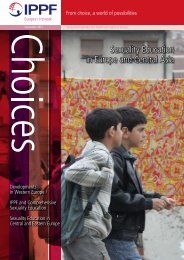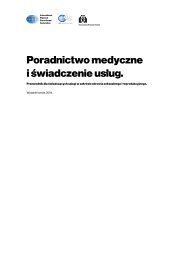Annual Report - IPPF - International Planned Parenthood Federation
Annual Report - IPPF - International Planned Parenthood Federation
Annual Report - IPPF - International Planned Parenthood Federation
You also want an ePaper? Increase the reach of your titles
YUMPU automatically turns print PDFs into web optimized ePapers that Google loves.
16 | <strong>IPPF</strong> EN <strong>Annual</strong> <strong>Report</strong> 2011 Highlights PERFORM<br />
“the process of accreditation gives an Association<br />
a chance to ‘stand still’ and look<br />
at its own work. it gives time and space<br />
for reflection, consideration and evaluation.<br />
During our stay in uzbekistan, i was<br />
overwhelmed with admiration for the enthusiasm<br />
and courage of the personnel and<br />
volunteers of the Association. i was inspired<br />
by their creativeness and strategic way of<br />
working in a difficult environment. their<br />
perseverance and strength can only make<br />
me humble.”<br />
Carine Vrancken- sensoa (Belgium), a 2011 volunteer<br />
to sharing their experiences with<br />
others.<br />
system strengthening<br />
The increased demand for indicators<br />
means that the collecting of<br />
reliable data is extremely important.<br />
As part of <strong>IPPF</strong>’s Global Comprehensive<br />
Abortion Care Initiative<br />
(GCACI), the clinics belonging to<br />
the Member Associations of Albania<br />
and Kyrgyzstan were equipped<br />
with the electronic Clinical Management<br />
Information System (CMIS).<br />
This open source medical practice<br />
management system is being used<br />
in different Regions of <strong>IPPF</strong> to institutionalize<br />
clientcentred recording<br />
and filing and allows the recording<br />
of data on services and/or products<br />
provided for each client’s visit.<br />
One of the main aspects of the system<br />
is that it can easily generate reliable data<br />
reports. When generating reports on a<br />
regular basis, Member Associations and<br />
their clinics will be able to use the findings<br />
as a management tool at clinic or<br />
Member Association level to improve<br />
performance and quality of care.<br />
Global Indicator survey<br />
and statistics<br />
The Global Indicators (GI) programme<br />
was initiated in 2004 to monitor the<br />
implementation of <strong>IPPF</strong>’s strategic<br />
framework (20052015) and to identify<br />
areas where future investment is<br />
needed. Thirty Global Indicators were<br />
identified and are measured annually.<br />
Member Associations are asked<br />
every year to complete an online survey<br />
and a service statistics module to<br />
feed into <strong>IPPF</strong>’s GI data.<br />
The Regional Office uses the survey<br />
and service statistics results to identify<br />
where technical assistance is needed.<br />
The data also feeds into the performance<br />
reviews of the Member Associations,<br />
the results of which are<br />
taken into consideration for resource<br />
allocation. The data is also used by<br />
Member Associations to improve programmes<br />
and performance, for resource<br />
mobilization and for advocacy.<br />
In 2011, key achievements within<br />
our Region include:<br />
• 784,141 sexual and reproductive<br />
health services provided to young<br />
people by 19 Member Associations<br />
delivering services. This means that<br />
slightly more than half of all services<br />
delivered were provided to<br />
clients under 25 years of age.<br />
• 45 per cent of Member Associations<br />
have at least 20 percent<br />
young people on their governing<br />
board.<br />
• A total of 42 successful national<br />
policy initiatives and/or positive<br />
legislative changes occured in support<br />
of sexual and reproductive<br />
health and rights to which Member<br />
Associations have contributed.<br />
According to service statistics data,<br />
the Member Association of Kyrgyzstan<br />
ranked third among the<br />
top providers of abortionrelated<br />
services in the European Network.<br />
They stepped up their service delivery<br />
by providing 53 percent more<br />
abortionrelated services than in<br />
2010. The Kyrgyz Member Association<br />
also reported a notable<br />
increase in the number of poor<br />
marginalized, socially excluded or<br />
underserved clients: from 60% in<br />
2010 to 80% in 2011.





